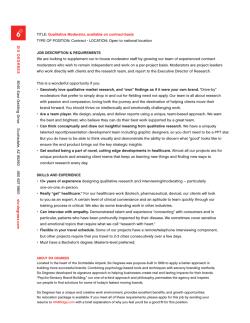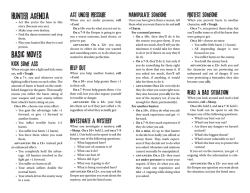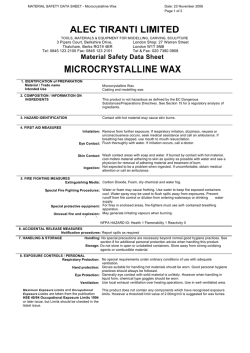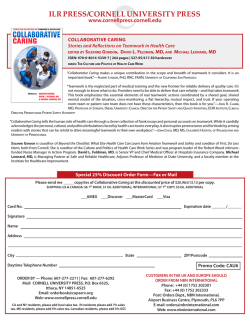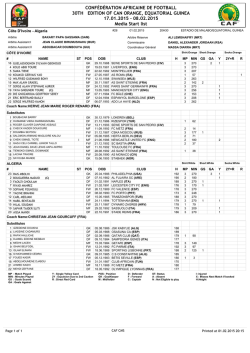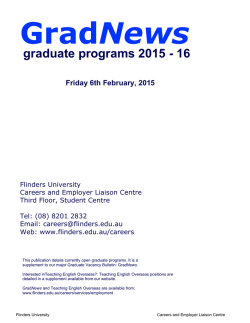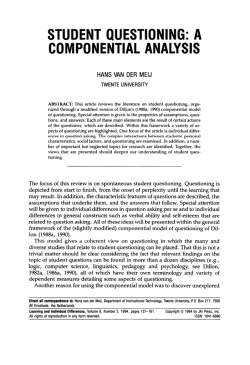
usq.edu.au
DOING RESEARCH WITH TEACHERS, PARENTS AND STUDENTS: THE ETHICS AND POLITICS OF COLLABORATIVE RESEARCH Carmen Mills and Trevor Gale Monash University, Australia Abstract: Truly collaborative research partnerships between universities and schools are seldom commonplace (Potter, 2001). Many schools – particularly those in disadvantaged communities – have long histories of being involved in research yet few see themselves with real investment in, ownership of and/or benefiting from the experience. In this chapter we discuss research conceived with more mutually beneficial researcher-researched relations, cognisant of the ‘importance of respecting and ultimately giving more than we take to the communities we research’ (Schultz, 2001, p. 1). The research involved teachers’, parents’ and students’ engagement with schooling in a secondary school in regional Australia. Rather than conducting the research on others, we attempted to craft our project with them. Michelle Fine (1994) argues that a decision to work with those we once might have written about or for, necessarily changes our work, making it both more ethical and more explicitly connected to struggles for social justice. This chapter draws on the voices of the teachers, parents and students we worked with and alongside during the research to explore the ethics and politics of such an approach. Citation: Mills, Carmen and Gale, Trevor (2004) Doing research with teachers, parents and students: The ethics and politics of collaborative research. In: Coombes, Phyllida and Danaher, Mike and Danaher, Patrick Alan, (ed.). Strategic uncertainties: ethics, politics and risk in contemporary educational research. Post Pressed, Flaxton, Qld, pp. 89-101. ISBN 1-87668272-8 Reproduced in accordance with the copyright policy of the publisher. Authors retain copyright. This is the authors’ final pre-publication version. Accessed from USQ ePrints http://eprints.usq.edu.au Introduction In her article, ‘Working the Hyphens,’ Michelle Fine (1994) invites researchers to re-examine their relationships with their informants, the space she calls the hyphen between the researcher and the researched. She argues that a decision to work with those we once wrote about or for will necessarily change our work, making it both more ethical and more explicitly connected to struggles for social justice (Schultz, 2001). As Fine explains: When we opt, as has been the tradition, simply to write about those who have been Othered, we deny the hyphen. Slipping into a contradictory discourse of individualism, personalogic theorising, and decontextualisation, we inscribe the Other, strain to white out Self, and refuse to engage the contradictions that litter our texts. When we opt, instead, to engage in social struggles with those who have been exploited and subjugated, we work the hyphen, revealing far more about ourselves, and far more about the structures of Othering. Eroding the fixedness of categories, we and they enter and play with the blurred boundaries that proliferate. (1994, p. 72, emphasis in original) Many schools – particularly those in disadvantaged communities – have long histories of being involved in research yet few see themselves with real investment in, ownership of and/or benefiting from the experience. According to Chataway (1997), externally directed interventions to help people solve their ‘problems’ have been of questionable value. Indeed: We are all too aware of the volumes of research in all fields, non-formal education included, which serve no purpose at all except the professional interests of the researchers. We are also aware of many cases when research is done by various institutions in order to take decisions for people who are not allowed to make decisions about their own lives. Our record as researchers is not a proud one. (Hall, 1981, p. 449) As the qualifications that enable people to contribute to the production of knowledge have inflated, it seems that more and more people have been excluded from naming their world (Hall, 1981). Yet, we believe that a commitment to more democratic forms of research remains important: The belief that ordinary people have both an ability and a right to interpret their problems and be involved in solutions is a fundamental element in any development of non-formal education and the key to long-lasting solutions. (Hall, 1981, p. 456) This chapter, then, explores the ethics and politics of collaborative research methods, which disrupt our thinking and practices, representing certain kinds of knowledge as privileged while others are discounted and silenced. Specifically, our interest is in how researchers can conduct research with rather than on others (Schultz, 2001), how we can research in truly collaborative ways alongside the ‘researched’. Designed to promote active involvement in every stage of the research process by those who are conventionally the focus of research, collaborative research strategically challenges the traditional hierarchical approach to research with a commitment to mutual inquiry and local ownership (Chataway, 1997). Background These are issues we take up in the context of research on the reproductive and transformative effects of secondary schooling (see, for example, Mills & Gale, in press). The small secondary school of some 200 students, which formed the case study for this research, is situated within an economically depressed area in regional Queensland, Australia. The township is characterised by its high welfare dependency and large indigenous population. The research was informed by and constituted a response to the state government’s Students at Educational Risk policy, particularly its references to the requirement for schools to identify students whose engagement with and prospects of ‘success’ within schooling is diminished by factors within schools themselves as well as by students’ particular social, cultural, economic and geographical contexts. The project sought to research what it means to ‘do school’ in one government school – for students and teachers and for the school’s administration and community – and to identify which students are not served well by these arrangements. The work of French sociologist, Pierre Bourdieu, particularly his conceptual triad of habitus, capital and field, provided the research with ways of conceiving of schooling that go beyond narrow attributions of blame for students and their families. A politics of recognition (Young, 1990; Gale & Densmore, 2000), particularly its emphasis on just social relations, also hinted at what might be done differently, thinking through relations between schools and their communities, and teachers, students and parents. In researching these issues, the project collected data from five main sources: questionnaires, structured interviews, semi-structured interviews, journals, and photographs. What made the conduct of the research unique compared with other research in schools was that the research team was constituted by both university-based and school-based researchers, working in partnership. The 13 school researchers were drawn from teachers (4), parents (4) and students (5), representing a diversity of interest groups in the School 1 . This commitment to doing research in partnership sought not only to recognise the voices of the people actually ‘doing school’ in this community, but it also sought to recognise these different voices in the processes of producing and analysing data. Joining with us to reinvent our roles and responsibilities in the research (Schultz, 2001), school researchers were involved in developing and adapting research instruments, distributed and analysed questionnaires, carried out follow-up interviews and took part in discussions analysing the results. Involving the ‘researched’ in the research process was a strategic position we took for both political and ethical reasons. It also exposed our research partners to ethical and political dilemmas of their own, which otherwise would have been closed to them. It is this moral discourse that we seek to foreground in this chapter, drawing it out of ‘the shadows of qualitative thought’ (Schwandt, 1989; cited in Flinders, 1992). We advance this discourse by drawing on the work of Flinders (1992) and through comparisons with the standards of a utilitarian ethical framework. It is a framework rendered familiar and orthodox through medical science research, adjudicating moral decisions on the basis of positive and negative consequences. From this perspective, the ethics of research can be judged against notions of informed consent, avoidance of harm, and confidentiality, each associated with different stages in the research process: ‘informed consent with the recruitment of participants, avoidance of harm with the conduct of fieldwork, and confidentiality with the writing of research reports’ (Flinders, 1992, p. 102). While they guide our ethical thinking ‘in ways that are remarkably consistent with the assumptions of largesample, quantitative research’ (Flinders, 1992, p. 102), over time, the concepts themselves have come to exemplify conventional traditions. In what follows we explore our engagement with these ethical conventions, particularly in the context of working alongside the researched. Informed consent Informed consent suggests that a researcher’s ethical duty goes well beyond obtaining the proper signatures on a consent form. In practical terms, ‘participants should enter into the research voluntarily, and they should know what they are getting into before deciding whether or not to take part in any given study’ (Flinders, 1992, p. 102). This posed considerable dilemmas for some school researchers who recognised the need to obtain such consent and yet were committed to the research proceeding. Some school researchers believed it was their duty to ‘convince’ their peers to agree to be interviewed for the research; perhaps not fully appreciating the importance of voluntary participation and/or struggling to reconcile this with their commitment to the task. For example, one student researcher mentioned the difficulties she had encountered in securing consent from those she sought to interview: ‘It’s pretty hard, like, convincing people the research was important … People backed out. They didn’t feel comfortable’ (S#1). In a similar vein, one parent mentioned that ‘some of [my 1 Extracts of conversations with school researchers are referenced according to (1) their position in the field, as Teacher (T), Parent (P) or Student (S); and (2) by number, to distinguish between those similarly positioned; thus: P#1, T#5, S#3, etc. interviewees] were very happy to be [involved]. Some I had to talk them into it’ (P#2). Another parent researcher ‘sensed reluctance from the people that I interviewed which sort of made me feel not quite comfortable, you know, interviewing some of these people. Because, like I say, they weren’t really comfortable with the process’ (P#3). As partners in the research, we too felt some unease at the thought of the ‘researched’ being cajoled into participation. In raising these issues within the research team, it became clear that our respective dilemmas centred around understandings of research as product and as process. In more traditional models of research – which tended to inform our school research partners’ understanding of research – research products loom large in importance, yet in collaborative research, the research process itself is of equal concern. As noted above, gaining consent from research participants involves more than simply acquiring their written approval. It also entails informing participants of what their participation means: the experience of participation as well as its consequences, including their experiences beyond the life of the research. This is difficult and uncertain terrain, perhaps even more difficult than securing signatures of participation. For consent to be genuinely informed, ‘the researcher must be able to predict with reasonable certainty the scope and focus of the research’ (Flinders, 1992, p. 102), which is of particular concern because ‘unlike experimental and large-sample research, qualitative inquiry does not aspire to high levels of predictability’ (Flinders, 1992, p. 102). As Flinders points out, it is therefore ‘legitimate to ask if qualitative researchers can inform others when they themselves do not know what twists and turns their work is likely to take’ (1992, p. 103). What began, then, almost as an exercise in pragmatics in securing interviewee participation, became a more ethical concern about our ability to truly inform participants of what they were getting themselves into. Clearly, the collaborative researcher is in ‘a perplexing situation. He or she needs to have done an ethnography of the setting in order to anticipate the range of risks and other burdens that will be involved for those studied’ (Erickson, 1986, p. 141; cited in Flinders, 1992). Such dilemmas underscored the importance for all in the research team of ‘being honest and forthright with prospective research participants’ (Flinders, 1992, p. 103), even to the extent of admitting when we were uncertain about possible research outcomes. Avoidance of harm A second consideration of research ethics, avoidance of harm, ‘holds that even when participants are fully informed and freely agree to participate, researchers are morally bound to conduct their research in ways that minimize potential risk or harm to those involved’ (Flinders, 1992, p. 103). Although the dangers of physical harm are less salient in qualitative studies than they are in experimental research and researchers in education might be tempted at first glance to argue that ‘in the absence of treatment groups, their work is comparatively benign in terms of potential risk’ (Flinders, 1992, p. 103), such argument ‘depends on defining risk in its most narrow physical sense’ (Flinders, 1992, p. 103). Teachers, for example, may ‘encounter risk to their professional reputations simply as a result of agreeing or not agreeing to take part in a study, or as a result of disclosing information about their work’ (Flinders, 1992, p. 103). For a qualitative researcher, then, the ‘avoidance of harm’ standard is ambiguously demanding: It demands too much in the sense that physical harm is usually not germane to the procedures at hand. We do not administer treatments or experimental interventions that are likely to effect a participant’s immediate physical well-being. But avoidance of harm conceived in this way also demands too little because it fails to recognize the full range of possible consequences that may result from taking part in the research. (Flinders, 1992, p. 103) The fact that our school-based research colleagues were known to the researched in this collaborative project, raised several issues for participants. As the researchers were the peers of the researched, there was the possibility that those interviewed may express or ‘have a totally different opinion’ (S#2) if they were interviewed by ‘outsiders’. That is, we were aware that interviewees’ perceptions of the possible harm of participation had the potential to influence their responses in the interviews. Cognisant that our research team included individuals variously positioned within the school, being a ‘team’ enabled us to be responsive to these perceived harmful effects of participation in ways that otherwise would not have been possible. Yet, while we decided that teachers would interview teachers, parents interview parents, and so on, this in itself did not guarantee avoidance of harm. Indeed, one teacher: … found it hard because I had to interview a teacher who hadn’t been here for very long. So that really impacted as well … [H]e’d only been here like a few weeks … And I also think, too, because I had three [people to interview] and I interviewed [them] as a group, made the others a little bit more aware of what they said in front of you because he was ‘brand new’ kind of thing, so maybe I should have talked to the other two together … and then spoken to him by himself. Because I think that they were very conscious of maybe not saying anything too ‘out there’. (T#1) The flexibility to interview participants in small groups or as individuals also presented possibilities to reduce the harmful effects of research. As another teacher pointed out, ‘I guess [interviewing] three together might have been an interesting experience, but one-onone I thought was probably a little bit, perhaps a bit safer’ (T#3). In such circumstances, then, a collaborative research process, which involves the use of ‘insiders’, can limit and enable data production. Illustrating this, one school researcher commented to another, ‘I think that some of the people you interviewed, if they had have talked to me, it would have just been a nightmare, yes. I would have got nothing out of them’ (T#1). A second school researcher found that some of the teachers who were not prepared to speak with university researchers: … made a few comments to me. I can’t remember what they said now … [T]hey were still guarded, but they did voice opinions. And to an extent I wasn’t overly surprised because having been here longer than anyone else amongst the teachers on this project, I’ve been around long enough to know I guess where they were coming from. (T#2) And, in a similar vein, a third researcher noted: At first I thought, ‘Oh my God, why aren’t [the university researchers] doing [the research themselves]?’, you know. Because I’d heard that the school had contributed money towards the research and stuff, and I just thought all we’re going to be doing is just helping them interview parents and things. And then … I realise[d] the value of actually getting people in the community involved because probably they may not have opened up as much to people from the university as they might have done with people that they know and maybe feel a little bit more comfortable with. (P#2) Making use of a collaborative research approach, then, helped to: … demystify the whole research process and empower the research group in that they developed knowledge, skills and confidence as they carried out the research. Finally, it helped to allay some of the suspicions of others about having research ‘done’ to them by outsiders with their own agendas. (Johnston, 2000, p. 77) It is easy to see, however, how the imbalance in age, status and power implicit in our relationships could complicate our invitations to school researchers to ‘join the research project and our attempts to blur the boundaries between researcher and researched’ (Schultz, 2001, p. 6). Our institutionally privileged position of university researchers possibly created a regime where students and parents (and perhaps even teachers) felt compelled to collaborate in the research and to represent the experience as positive and empowering (Burke, 2002). That is, we were aware of the possibility of perceived harm for school researchers who either opted not to participate as researchers or whose participation was constructed in negative terms. It is little wonder, then, that there are concerns that participatory research is simply another strategic means of co-opting community members through a rhetoric of involvement (BrydonMiller, 1997). Powerful groups have been known to offer participation in decision making to less powerful groups as a way of manipulating, co-opting, or placating them (Arnstein, 1969). Cognisant of these issues, we were concerned to position school researchers as central to the production of knowledge with opportunities to exercise their agency: taking an active role in addressing issues that affect themselves, their families, and their communities (Gaventa, 1988) rather than being passive recipients of investigations or experimentation, or mere consumers of the study. In this way, collaborative research complicates traditional notions of ‘using’ others in research and focuses instead on the unique skills and knowledges we each bring to the relationship and offer to one another (Schultz, 2001). As Erica Burman points out, we need to avoid seeing the use of these methods as simply a more convenient or more compelling way of convincing people to divulge important aspects of their lives to us (BrydonMiller & Tolman, 1997). In short, involving those directly affected by research in the production of knowledge is understood within collaborative research as one way of avoiding harm. In our research, many appeared pleased, even honoured, to be invited to participate as coresearchers. Low self-esteem and low confidence were issues for some parents and students after years of being positioned as ‘low-achievers’ or ‘unemployed’. As one parent researcher commented: I felt like I was valued as more … maybe not [equally] educated but equally valuable for this research knowing that we were working with people from the university – which you always think, ‘Oh, they’re so educated and know so much’ and yet here we are, we’re being asked to help in something like this. It’s quite flattering. (P#2) The research even appeared to enable some parent researchers to move on, in terms of further education, community and voluntary work and paid employment (Johnston, 2000). For example, shortly after the completion of the project one parent applied for and gained entry to the nearby university, utilising her involvement as a researcher in the project to demonstrate her academic abilities and demonstrate equivalent entry-level qualifications. More generally, most school researchers were able to engage in the political act of ‘claim[ing] an identity, rather than passively accept[ing] one’ (Dei, 1997, p. 241). As an approach to research that makes an explicit commitment to working with members of communities that have traditionally been exploited and oppressed (Maguire, 1987), it is not difficult to see why participatory research projects are often conceived as ways to empower people to change the circumstances of their lives (Schultz, 2001). Confidentiality Finally, confidentiality ‘is intended to protect research participants from a particular type of risk – stress, embarrassment, or unwanted publicity resulting from the publication of research findings’ (Flinders, 1992, p. 103). Participants are typically protected through the use of pseudonyms or coding systems to conceal their identities ‘in situations where the information they reveal to a researcher can be used against them by others’ (Flinders, 1992, p. 103). However, protecting confidentiality is a more difficult process in qualitative research than it is in other types of research. This is because: … most qualitative investigations strive to render vividly the lives of those studied. Detailed portraits and “thick description” do not lend themselves to disguising an individual’s identity. On this count, the better the research, the more readily others can recognize participants, and the more readily participants can recognize themselves. (Flinders, 1992, p. 103-104) Such difficulties can lead to significant problems should information about participants be recognisable to people who have the power to use that information for exploitative purposes. This was a very real concern for several participants in our research. As one parent researcher suggested, ‘the confidentiality thing, that was the big thing for everyone. [The parents I interviewed] still [are] not sure that they can’t be identified’ (P#1). Her response was to ‘just reassure [the people I interviewed] that no one at the school would hear their tapes. It would just go to the university. The school would just get, like, a hard copy with all identifying remarks removed’ (P#1). But for participants, and others in the research team, these are not necessarily comforting reassurances. As noted above, participants, even when their names are removed from transcripts, can be identified by the nature of their comments, their knowledge of events and so on; a very real concern in a small school and community where individuals are well known to each other. Moreover, the researcher’s assurances above did not accurately reflect the intentions of the research team: to provide the school with excerpts from transcripts in the context of a report. In this way we planned to further provide for participants’ anonymity, excluding comments and events that would more easily identify them to others in the school. Such misconceptions by researchers about the presentation of data, which may have influenced the decision of those they invited to participate, are more difficult to avoid in collaborative research projects involving large numbers of researchers, some of whom are new to the ethical and political dimensions of research. In our research, workshops with school researchers were conducted prior to data production to address these very issues. Still, the above inaccuracies remind us of the need for ongoing dialogue within collaborative research teams about how data will be stored, used and presented, and the need to be accurate in our explanations of these matters with participants. Accessibility of the raw data – the interview audiotapes – also featured in participants’ and school researchers’ concerns about confidentiality. Several interviewees questioned whether ‘the Principal or someone else was going to hear [the audiotape]. They were very reluctant about getting taped’ (S#1). So although ‘some people just said what they wanted to say. A couple didn’t … [E]ven after I told them about how anonymous it was going to be, they were still worried’ (P#2). Other parent researchers confirmed these participant concerns about access to the data: I even had one [parent] that reckoned that her voice would be recognised so she wound up bailing out completely at the last moment, and I had to then look for another person [to interview]. So she was extremely worried that her voice would be recognised on tape, and no matter how I tried to convince her that it was confidential, that nobody in this school was going to hear the tape, no way would she commit herself. (P#3) Even one of the student researchers admitted that ‘I myself was worried about it. Not that I don’t trust people … but I mean it’s temptation, like where we had to leave [the audiotapes] and that’ (S#3). As one parent explained, ‘I think the problem was that the tapes were stored in [the Principal’s] office … I wonder if you were to do this again there may be a more direct way of delivering the tapes [to the university for transcribing]’ (P#2). Other parent researchers used their own initiative to ensure the confidentiality of the data: ‘I actually sealed all of [my tapes] in an envelope … because I thought I have a commitment to these people to make sure that I’ve done as much as I can to [ensure their confidentiality]’ (P#3). In a more traditional research approach this may not have been an issue as the university researcher would normally conduct the interview and take the tape with them, thereby removing the possibility of it being accessed by ‘insiders’. Staff members, too, were wary of having their opinions recorded, some refusing to sign consent forms: Two of [the people I had intended to interview] just flatly refused … One of them said, ‘Oh, I’ll talk to you but I won’t put it on tape’. And one of them actually said [they] wouldn’t sign the release form. And I said, ‘Look, I can’t interview without getting your approval’ … [So] they wouldn’t put their moniker on anything, even to actually sign the form … [T]hey backed off even further with an element of ‘big brother’. (T#3) However, most school researchers had a quite different experience, one interviewing an ‘extremely vocal parent who was probably all criticisms and no actual positives and she couldn’t have cared less if [the school] knew how she felt’ (P#3). In fact, some ‘were glad. They said, “I don’t care if the school knows what I think of it”’ (P#1). In short, while ‘some people are really happy to have an avenue where they can tell [the school] just exactly what their problems are’ (P#2), for others issues of confidentiality loomed large in their minds. Conclusion The ethical and political uncertainties faced by our collaborative team of student, parent, teacher and university researchers underscore the need for us to ‘rethink the ethical foundations of qualitative research, not in an effort to gloss over the problems we face, but as a means for seeking more adequate safeguards than those based strictly on a utilitarian approach’ (Flinders, 1992, p. 104). More specifically, collaborative research provides a framework that allows those of us committed to working with communities for the achievement of positive social change to ‘tell the stories from the side of policy that is never asked to speak, to interrupt the hegemony of elite voices dictating what is good for this segment of the population’ (Fine & Weis, 1996, p. 269). However, the ethical and political issues related to undertaking such research cannot be overlooked. New recruits to research may not be as familiar as those who work within academia, with ethical standards such as informed consent, avoidance of harm, and confidentiality. For collaborative research to be successful, then, we must be prepared to invest our time, personal energy and commitment (Brydon-Miller & Tolman, 1997) to help others gain access to such understandings. We, too, need to be open to challenges to these understandings. In considering the standard of avoidance of harm, for example, we need to perceive ‘harm’ more broadly. We have argued, for instance, that the exclusion of the researched from the production of knowledge can have potentially harmful effects. Many disadvantaged schools and communities in particular have endured research on them without any appreciable benefit, at least not to the researched. We also need to be ‘vigilant and reflexive about ethical issues and cognisant of how power might be used – and misused – in our research’ (Schultz, 2001, p. 22). That is, we need to remain mindful of power inequities inherent in our research relationships. As Katherine Schultz (2001) points out, power and privilege inevitably shape the roles that are available to participants in research projects. Finally, we must consider that issues of confidentiality will invariably arise as a result of ‘insiders’ being a part of the research process. Information about participants being recognisable to people who have the power to use that information for exploitative purposes, for instance, was a very real concern for many involved in our research. However, according to Flinders, it is our duty as researchers to ‘learn to “read” ethical concerns as they emerge, anticipate relevant considerations, and recognize alternative points of view. In qualitative research, these skills are not marginal; they are at the heart of what we do’ (1992, p. 114). References Arnstein, S. (1969). Ladder of citizen participation. Journal of the American Institute of Planners, 35(4), 216-224. Brydon-Miller, M. (1997). Participatory action research: Psychology and social change. Journal of Social Issues, 53(4), 657-666. Brydon-Miller, M., & Tolman, D. L. (1997). Engaging the process of transformation. Journal of Social Issues, 53(4), 803-810. Burke, P. J. (2002). Towards a collaborative methodology: An ethnography of widening educational participation. Australian Educational Researcher, 29(1), 115-136. Chataway, C. J. (1997). An examination of the constraints on mutual inquiry in a Participatory Action Research project. Journal of Social Issues, 53(4), 747-765. Dei, G. (1997). Race and the production of identity in the schooling experiences of AfricanCanadian youth. Discourse, 18, 241-257. Erickson, F. (1986). Qualitative methods in research on teaching. In M. C. Wittrock (Ed.), Handbook of research on teaching (3rd ed., pp. 119-161). New York: Macmillan. Fine, M. (1994). Working the hyphens: Reinventing self and other in qualitative research. In N. R. Denzin & Y. S. Lincoln (Eds.), Handbook of qualitative research (pp. 70-82). Thousand Oaks, CA: Sage. Fine, M., & Weis, L. (1996). Writing the "wrongs" of fieldwork: Confronting our own research/writing dilemmas in urban ethnographies. Qualitative Inquiry, 2(3), 251-274. Flinders, D. J. (1992). In search of ethical guidance: Constructing a basis for dialogue. Qualitative Studies in Education, 5(2), 101-115. Gale, T., & Densmore, K. (2000). Just schooling: Explorations in the cultural politics of teaching. Buckingham: Open University Press. Gaventa, J. (1988). Participatory research in North America. Convergence, 24(2-3), 19-28. Hall, B. L. (1981). The democratization of research in adult and non-formal education. In P. Reason & J. Rowan (Eds.), Human inquiry: A sourcebook of new paradigm research (pp. 447-456). Chichester: John Wiley & Sons. Johnston, R. (2000). Whose side, whose research, whose learning, whose outcomes? Ethics, emancipatory research and unemployment. In H. Simons & R. Usher (Eds.), Situated ethics in educational research (pp. 69-81). London: Routledge. Maguire, P. (1987). Doing participatory research: A feminist approach. Amherst, MA: Center for International Education, University of Massachusetts. Mills, C. & Gale, T. (in press) Transient Teachers: How one community interprets the messages of schooling in regional Australia. Journal of Research in Rural Education. Potter, G. (2001). Facilitating critical reflection on practice through collaborative research. Australian Educational Researcher, 28(3), 117-139. Schultz, K. (2001). Stretching the boundaries of participatory research: Insights from conducting research with urban adolescents. Australian Educational Researcher, 28(2), 1-28. Schwandt, T. A. (1989). Recapturing moral discourse in evaluation. Educational Researcher, 18, 11-16. Young, I. M. (1990). Justice and the politics of difference. Princeton: Princeton University Press.
© Copyright 2025
